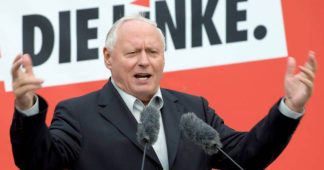Jul 9, 2024
In Europe the extreme centre is fading. While the far right is gaining momentum the left has finally dashed out of the starting blocks
Costas Lapavitsas is Professor of Economics at the School of Oriental and African Studies andconvenor at European Research Network on Social and Economic Policy. He is the lead author together with the EReNSEP Writing Collective of “The State of Capitalism: Economy, Society, and Hegemony” that was published in December. Read our Book Review HERE
A new political landscape
The recent bout of elections in Europe confirmed the retreat of the extreme centre, the political current that has determined the fate of the continent for decades as centre-right and centre-left. A new far right is on the rise.
The main trend is not in dispute. The French far right came third in seats but still chalked up the biggest gains. Support for the centre left collapsed in Germany, accompanied by the rise of a far right with fascist undertones. A virulent far right took power in Holland. Even in peripheral Greece, the centre right government suffered a major defeat, coupled by the rise of the far right.
The most important result, however, was the resurgence of the radical left in France. In one fell swoop the French people showed that, despite frequent assertions to the contrary, the historic divide between right and left is far from over. On the contrary, it remains at the heart of political life in contemporary capitalism.
Despite the retreat of the extreme centre, it would be a mistake to underestimate its durability. In the British election, the centre right represented by the Conservative Party was crushed and the main beneficiary of was Farage’s far right. But the victor was the Labour Party, confirming that there is life in the centre left, even if there was no electoral upsurge in its favour. In France too, the defeated Macron managed to come second.
Still, political developments across the continent in the immediate future will pivot on the opposition between the far right and the radical left. This calls for a deeper look at the political economy of contemporary Europe.
Politics and economics of the extreme centre
The extreme centre -an apt term coined by Tariq Ali, historic figure of the British radical left- is marked by three features in Europe.
First, it fully accepts economic neoliberalism and propounds the putative merits of the free market over the state. In practice, neoliberal policies systematically mobilise the mechanisms of the state to favour capital at the expense of labour. This is the true meaning of being “pro-enterprise”.
Second, it has subordinated the continent to global American hegemony, treating the constant expansion of NATO as a guarantee of peace and unquestioningly supporting the projection of American power.
Third, it has adopted an ideology dominated by protecting the environment and defending the rights of personal identity, be that of gender, race, religion, etc. Crucially, national identity is typically excluded from the mix. Moreover, protecting the environment and defending rights are perceived as individual rather than collective obligations. Anyone who disagrees is not simply wrong, but probably also an immoral person.
These features make the extreme centre dogmatic and authoritarian, leaving little in common with classical liberalism. Macron’s government, for instance, harshly repressed social movements and solidarity for Palestine, while passing anti-immigrant and islamophobic legislation copied from the far right. Examples could be easily multiplied from elsewhere.
By the same token, however, the extreme centre has been an excellent servant of the needs of globalised and financialised capitalism, creating a political framework for giant multinationals and financial institutions to dominate the world economy. It has provided the politics needed to establish productive capacity abroad, transact loanable capital globally, import commodities cheaply, and bring huge numbers of workers from peripheral countries to do the worst jobs.
The exhaustion of this model of capitalist accumulation became evident after the landmark event of the Great Crisis of 2007-9. The period that followed could be described as an interregnum: the old cannot continue as before, but the new cannot emerge. This is where the roots of the decline of the extreme centre and the rise of the far right lie.
In Europe, more specifically, the political dominance of the extreme centre was established within the institutional framework of the EU. The shift of the Union towards neoliberalism after the 1980s produced vast bureaucratic institutions that speak the language of the free market, but systematically introduce legal and administrative measures to favour big capital.
As globalised and financialised capitalism ran out of steam, the EU entered historic decay. It is plagued by low growth rates, huge inequalities of income and wealth, dismantling of the welfare state and divergence between countries in the core and in the periphery. Its institutional machinery lacks direction and is run by third-rate politicians, who increasingly reek of corruption.
The daily reality of the working class of EU member states – in view especially of the inflation spike since in 2022- is an endless struggle to make ends meet while horizons are lowering. Popular discontent has inevitably swelled, leading to the accelerated retreat of the extreme centre. The main beneficiary has generally been the far right, and this also calls for a closer look.
The new far right
The nascent far right in Europe collects components of the political spectrum beyond the centre-right. It often includes elements of the fascist right but is not identified with it.
The far right poses no danger to the neoliberal economic regime in Europe. Meloni’s far right government in Italy, for example, has not deviated from the disastrous economic policies of recent decades. Le Pen’s economic programme worried neither the French ruling class, nor the centres of global power in Washington.
The far right also poses no danger to Europe’s subordination to American hegemony. There are different voices within it, for instance, Orban, Farage and even Le Pen, on Ukraine. But these do not represent rebellion, or the taking of an independent path. They are attempts to rationalise an extremely belligerent and incoherent American foreign policy.
In short, the far right in Europe presents no alternatives to the economic and geopolitical arrangements of the extreme centre. It offers no material solutions for the enormous problems facing workers and the poor in the interregnum. But it throws a challenge to the dominant ideology by laying the blame for these problems on the dominant views regarding climate, gender, migration, the environment, etc.
The far-right challenge to the prevalent theories on climate change, for instance, resonates with the popular strata of Europe, forced to bear the brunt of the “Green Transition” as higher energy costs. Big business, meanwhile, continues to make huge profits from fossil fuels, while moving aggressively toward “green” sources of energy.
Even greater resonance is found for far-right emphasis on national identity, that is, on the most prominent part of the identity of workers and the poor in Europe, no matter what the extreme centre believes. It poses immigration as a threat to national identity and finds an easy culprit for the hardships of workers and the poor. Racism and xenophobia hide behind the mask of concern for the suffering indigenous population.
There is nothing quite like a perceived threat to identity to create the risk of social instability. This is why the rise of the far right is a source of concern for the ruIing classes of Europe.
Le Pen’s party, for instance, constantly stresses «national preference» or «national priority». Combined with extreme islamophobia, this would lead to a segregated society based on racist criteria. It would be vastly different from the liberal-democratic regimes of the last four decades.
The danger is real especially if the fascist currents within far-right parties are taken into account. Le Pen’s party contains hard-core fascists who know how to adapt their poisonous ideology to the conditions of the interregnum under the cloak of concern for working people. Immigration has been their favourite hunting ground. Similar efforts are made by the even more hardline fascists of the AfD in Germany.
The clearest sign of the flexibility of the far right in this regard is its adaptability to the rules and institutions of the EU. The way was paved by Meloni, and Le Pen has followed. The threat of exit is by and large forgotten. Both have realised that the present-day authoritarian, neoliberal and aimless EU, could become compatible with the new far right. The vast majority of voters supporting far right parties across Europe might not be fascist, but the fascist danger is real.
The stunning return of the left
It is, therefore, very important that there has also been a stunning return of the left, and I am not, of course, referring to Starmer’s Labour Party, a true exponent of the centre left in the UK. The share of the vote won by Starmer was significantly less than Corbyn’s in 2017, and the total number of votes was lower than even the election of 2019, when Corbyn’ Labour Party presumably had a disaster.
British voters showed no enthusiasm for Starmer but crushed the incompetent centre right of the Conservative Party. The real winner was Farage’s far right, which has the potential to influence future developments. The causes are fundamentally the same as for the rest of Europe, and perhaps even more acute as the travails of the interregnum are especially pronounced in the UK.
The UK centre left demonstrated the ability to persevere in these conditions. One should also bear in mind that the British working class has historically kept its distance from fascism. The party of Farage contains racist and xenophobic elements, but no overt fascism. Britain is likely to follow its own path, and that will not include going back to the EU.
The real return of the left occurred with the French New Popular Front, at the heart of which lies Mélenchon’s La France Insoumise. The danger of fascism led broad layers of the workers and the poor of France to the only force that could truly oppose it. LFI represents a structural threat to failing French globalisation and financialisation in ways that do not even remotely apply to the far right. That is why the Front led by LFI has found popular resonance.
Specifically:
LFI stressed unity not only in words but deeds. Already in 2022 it took the initiative to establish the broad front of NUPES to contest the presidential election. In France, which has experienced constant social conflict in recent years – pensions, trade unions, Yellow Vests – the stress on unity has had powerful popular appeal.
The party also had the courage to challenge US hegemony, even arguing in favour of exiting NATO. LFI openly condemned the USA for its role in supporting the genocide of the Palestinians in Gaza. The response by the French poor of Arab origin was massive.
Finally, LFI provided the foundations for the economic proposals of the New Popular Front. They entailed undoing Macron’s disastrous measures regarding pensions as well as taxing corporations and the rich, raising the minimum wage, and taking steps toward restructuring the economy. It is no surprise that Olivier Blanchard – French professor at MIT and former chief economist of the IMF – attacked the programme relentlessly.
To be sure, Macron’s centre right has also endured and France is now set for a period of profound political instability, in which the far right will be very active. Le Pen’s party won a majority among blue-collar workers and attracted broad layers of white-collar workers, pensioners, professionals, etc.
Support for the New Popular Front is strongest among public sector workers, the young, and the non-white working class. The significance of its triumph is that it has come by openly arguing that immigration is not the cause of France’s problems. Much will now depend on how Mélenchon’s party conducts itself, especially if it succeeds in creating an effective party apparatus throughout the country.
France is the classic site of political evolution in Europe. The French election has shown that the left can be a natural pole of attraction for workers and the poor, when it is united and challenges the foundations of economic and social power. In the looming struggles of the interregnum, as the extreme centre retreats and the far right flexes its muscles, the lesson will be of paramount importance.
We remind our readers that publication of articles on our site does not mean that we agree with what is written. Our policy is to publish anything which we consider of interest, so as to assist our readers in forming their opinions. Sometimes we even publish articles with which we totally disagree, since we believe it is important for our readers to be informed on as wide a spectrum of views as possible.











